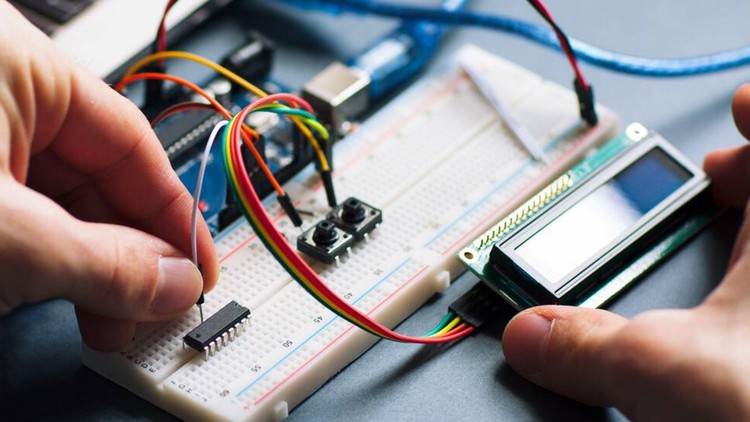Microcontroller Embedded C Programming: Absolute Beginners
Microcontroller Embedded C Programming: Absolute Beginners Certification Course
What you’ll learn
Microcontroller Embedded C Programming: Absolute Beginners
-
8051 microcontroller family
-
Reading switches
-
Adding structure to code
-
Real-time constraints
Requirements
-
Access to Smart Phone / Computer
-
Good Internet Speed (Wifi/3G/4G)
-
Good Quality Earphones / Speakers
Description
An embedded system is an application that contains at least one programmable computer (typically in the form of a microcontroller, a microprocessor, or a digital signal processor chip) and which is used by individuals who are, in the main, unaware that the system is computer-based. The use of embedded processors in passenger cars, mobile phones, medical equipment, aerospace systems, and defense systems is widespread, and even everyday domestic appliances such as dishwashers, televisions, washing machines, and video recorders now include at least one such device.
This course provides a ‘hardware-free’ introduction to embedded software for students who:
- Already know how to write software for ‘desktop’ computer systems.
- Are familiar with a C-based language (Java, C++, or C).
- Want to learn how C is used in practice embedded systems?
Chapter 1 Programming embedded systems in C
- Introduction
- What is an embedded system?
- Which processor should you use?
- Which programming language should you use?
- Which operating system should you use?
- How do you develop embedded software?
- Conclusions
Chapter 2 Introducing the 8051 microcontroller family
- Introduction
- What’s in a name?
- The external interface of the Standard 8051
- Reset requirements
- Clock frequency and performance
- Memory issues
- I/O pins
- Timers
- Interrupts
- Serial interface
- Power consumption
- Conclusions
Chapter 3 Hello Embedded World
- Introduction
- Installing the Keil software and loading the project
- Configuring the simulator
- Building the target
- Running the simulation
- Dissecting the program
- Aside: Building the hardware
- Conclusions
Chapter 4 Reading switches
- Introduction
- Basic techniques for reading from port pins
- Example: Reading and writing bytes
- Example: Reading and writing bits (simple version)
- Example: Reading and writing bits (generic version)
- The need for pull-up resistors
- Dealing with switch bounce
- Example: Reading switch inputs (basic code)
- Example: Counting goats
- Conclusions
Chapter 5 Adding structure to your code
- Introduction
- Object-oriented programming with C
- The Project Header (MAIN.H)
- The Port Header (PORT.H)
- Example: Restructuring the ‘Hello Embedded World’ example
- Example: Restructuring the goat-counting example
- Further examples
- Conclusions
Chapter 6 Meeting real-time constraints
- Introduction
- Creating ‘hardware delays’ using Timer 0 and Timer 1
- Example: Generating a precise 50 ms delay
- Example: Creating a portable hardware delay
- Why not use Timer 2?
- The need for ‘timeout’ mechanisms
- Creating loop timeouts
- Example: Testing loop timeouts
- Example: A more reliable switch interface
- Creating hardware timeouts
- Example: Testing a hardware timeout
- Conclusions
Chapter 7 Creating an embedded operating system
- Introduction
- The basis of a simple embedded OS
- Introducing EOS
- Using Timer 0 or Timer 1
- Is this approach portable?
- Alternative system architectures
- Important design considerations when using EOS
- Example: Milk pasteurization
- Conclusions
Chapter 8 Multi-state systems and function sequences
- Introduction
- Implementing a Multi-State (Timed) system
- Example: Traffic light sequencing
- Example: Animatronic dinosaur
- Implementing a Multi-State (Input/Timed) system
- Model: Controller for a washing machine
- Conclusions
Chapter 9 Using the serial interface
- Introduction
- What is RS-232?
- Does RS-232 still matter?
- The basic RS-232 protocol
- Asynchronous data transmission and baud rates
- Flow control
- The software architecture
- Using the on-chip UART for RS-232 communications
- Memory requirements
- Example: Displaying elapsed time on a PC
- The Serial-Menu architecture
- Example: Data acquisition
- Example: Remote-control robot
- Conclusions
Chapter 10 Case study: Intruder alarm system
- Introduction
- The software architecture
- Key software components used in this example
- Running the program
- The software
- Conclusions
Chapter 11 Where do we go from here
- Introduction
- Have we achieved our aims?
- Suggestions for further study
- Patterns for Time-Triggered Embedded Systems
- Embedded Operating Systems
- Conclusions
Who this course is for:
- Want to learn how C is used in practice embedded systems
8051 Microcontroller – Embedded C and Assembly Language Course
Get Course Now









